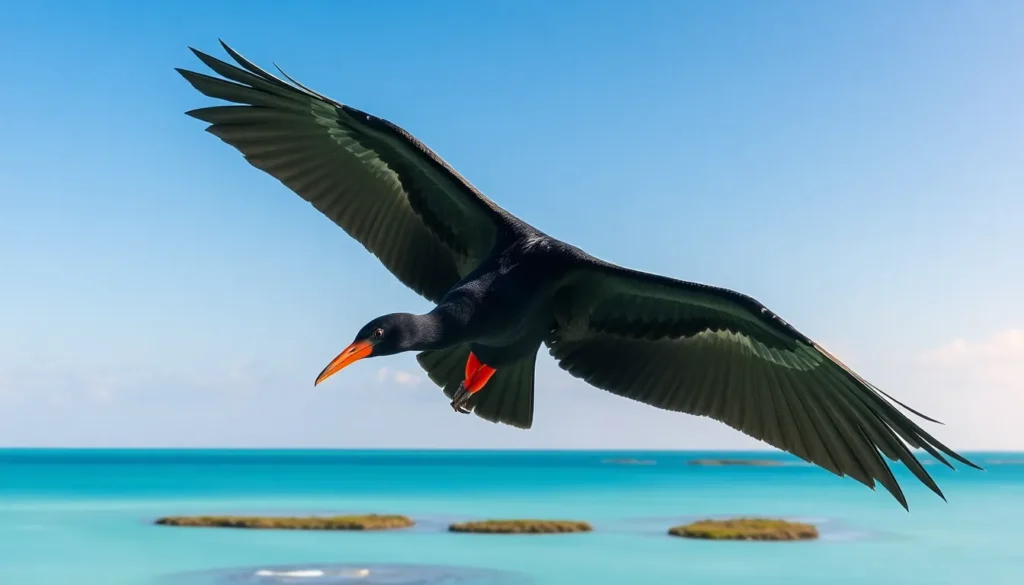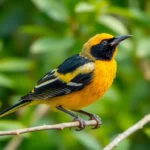Picture a bird so cunning it steals food right from other seabirds’ beaks. We’re talking about the magnificent frigatebird – nature’s most notorious aerial pirate. These incredible creatures have earned their swashbuckling reputation through brazen acts of kleptoparasitism that’d make even Blackbeard jealous.
With wingspans reaching up to eight feet and razor-sharp beaks, frigatebirds patrol tropical coastlines like feathered buccaneers. They’ve mastered the art of mid-air theft, swooping down to harass other birds until they regurgitate their hard-earned meals. It’s a spectacular display of aerial agility that’s both ruthless and mesmerizing.
But there’s so much more to these fascinating pirates than their thieving ways. From their inflatable red throat pouches to their incredible soaring abilities, frigatebirds represent one of nature’s most remarkable evolutionary success stories. Let’s jump into the captivating industry of these airborne marauders.
What Is a Pirate Bird?
Magnificent frigatebirds earn the nickname “pirate bird” through their aggressive kleptoparasitic behavior, which involves stealing food directly from other seabirds. These aerial thieves target boobies, pelicans, and tropicbirds by harassing them mid-flight until their victims regurgitate their catch.
Physical characteristics distinguish frigatebirds from other seabirds through several unique features:
- Wingspan: Males reach 7.5 feet across while females span up to 8.5 feet
- Weight: Adults weigh between 2.2 to 4.4 pounds even though their massive size
- Beak: Sharp, hooked bills measure 4-5 inches long for precision strikes
- Wings: Exceptionally long and narrow design enables superior maneuverability
Males display a distinctive inflatable red throat pouch called a gular sac during breeding season, which can expand to the size of a party balloon. Females lack this dramatic feature but possess white chest patches that make them easily identifiable in flight.
Hunting strategies employed by frigatebirds demonstrate their opportunistic nature beyond simple theft. Direct fishing occurs when they skim the ocean surface to catch flying fish, squid, and small tuna. Surface plunging allows them to dive briefly into shallow waters for prey, though their reduced waterproofing limits underwater time to mere seconds.
Habitat preferences place frigatebirds exclusively in tropical and subtropical coastal regions where warm currents provide abundant marine life. These birds inhabit mangrove islands, coral atolls, and rocky coastlines across the Pacific, Atlantic, and Indian Oceans.
Five distinct frigatebird species exist worldwide, with the magnificent frigatebird representing the most widespread and commonly observed variety throughout the Caribbean, Galápagos Islands, and Pacific coast of the Americas.
Physical Characteristics of Pirate Birds
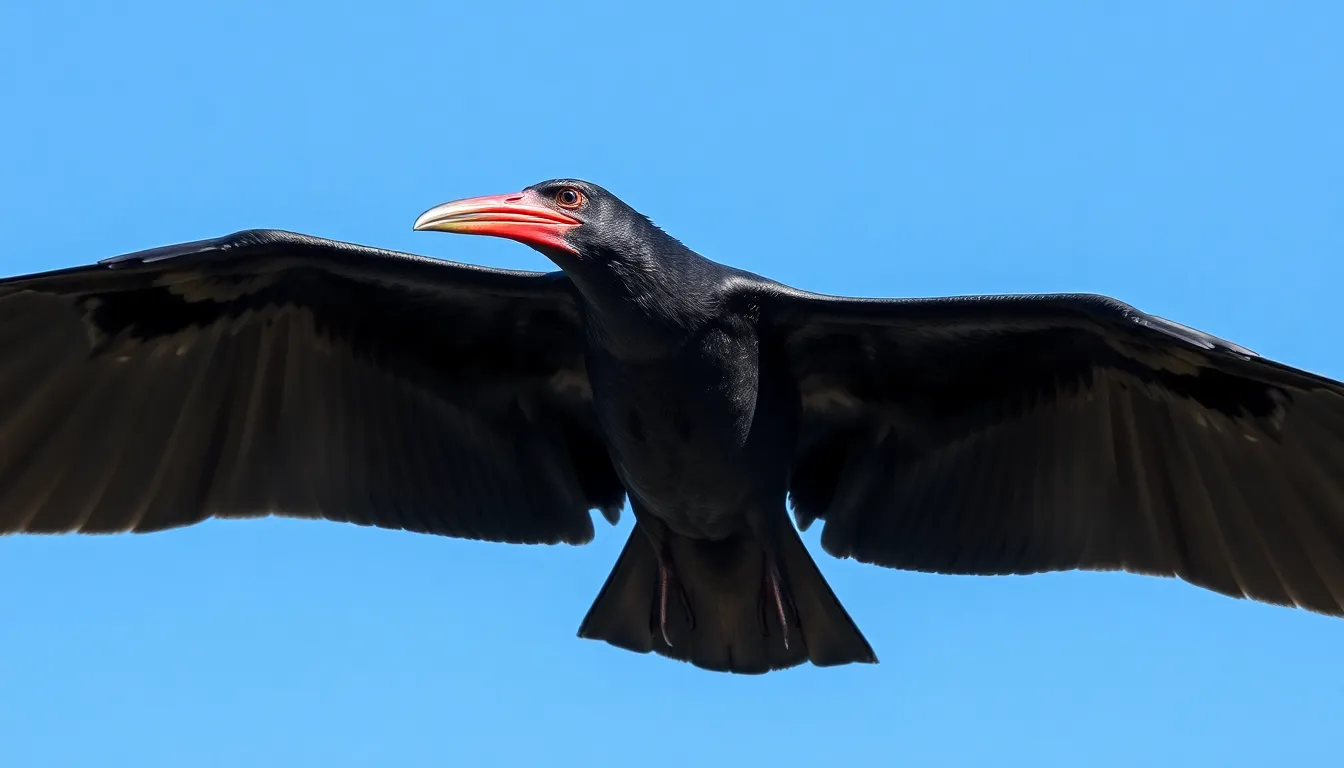
Magnificent frigatebirds display remarkable physical adaptations that make them exceptional aerial predators. These specialized traits enable their pirate bird lifestyle and distinguish them from other seabirds.
Size and Build
Frigatebirds rank among the largest seabirds by wingspan even though their surprisingly light body weight. Males measure 35-45 inches in length while females reach 37-50 inches. Their wingspan creates an impressive silhouette with males achieving 7.5 feet and females extending up to 8.5 feet across.
Body weight remains disproportionately light compared to their size. Males typically weigh 2.2-3.3 pounds while females range from 2.4-3.7 pounds. This lightweight build provides exceptional maneuverability during aerial pursuits and extended flight periods.
Wing structure features elongated bones and reduced muscle mass in non-essential areas. The sternum appears smaller relative to body size compared to other large seabirds. Hollow bones contribute to their reduced weight while maintaining structural integrity for powerful flight capabilities.
Distinctive Features and Coloring
Adult male frigatebirds exhibit glossy black plumage across their entire body with metallic green and purple sheens visible in direct sunlight. The most striking feature remains their inflatable red throat pouch called a gular sac. During breeding season this crimson balloon expands to the size of a small beach ball.
Female frigatebirds display black plumage with distinctive white breast patches extending from throat to upper belly. Their heads often show brownish tinge while maintaining the same metallic sheen as males. Females lack the red gular sac but possess slightly larger overall body size.
Juvenile birds present mottled brown and white coloring with white head patches that gradually darken with age. Young frigatebirds require 4-6 years to develop full adult plumage patterns. Their bills remain pale pink or gray during early development.
Bill shape appears long and sharply hooked with serrated edges for gripping slippery prey. The upper mandible curves downward ending in a pronounced hook measuring 4-5 inches in total length. Eyes are positioned laterally providing excellent peripheral vision for spotting potential victims during kleptoparasitic attacks.
Behavior and Hunting Techniques
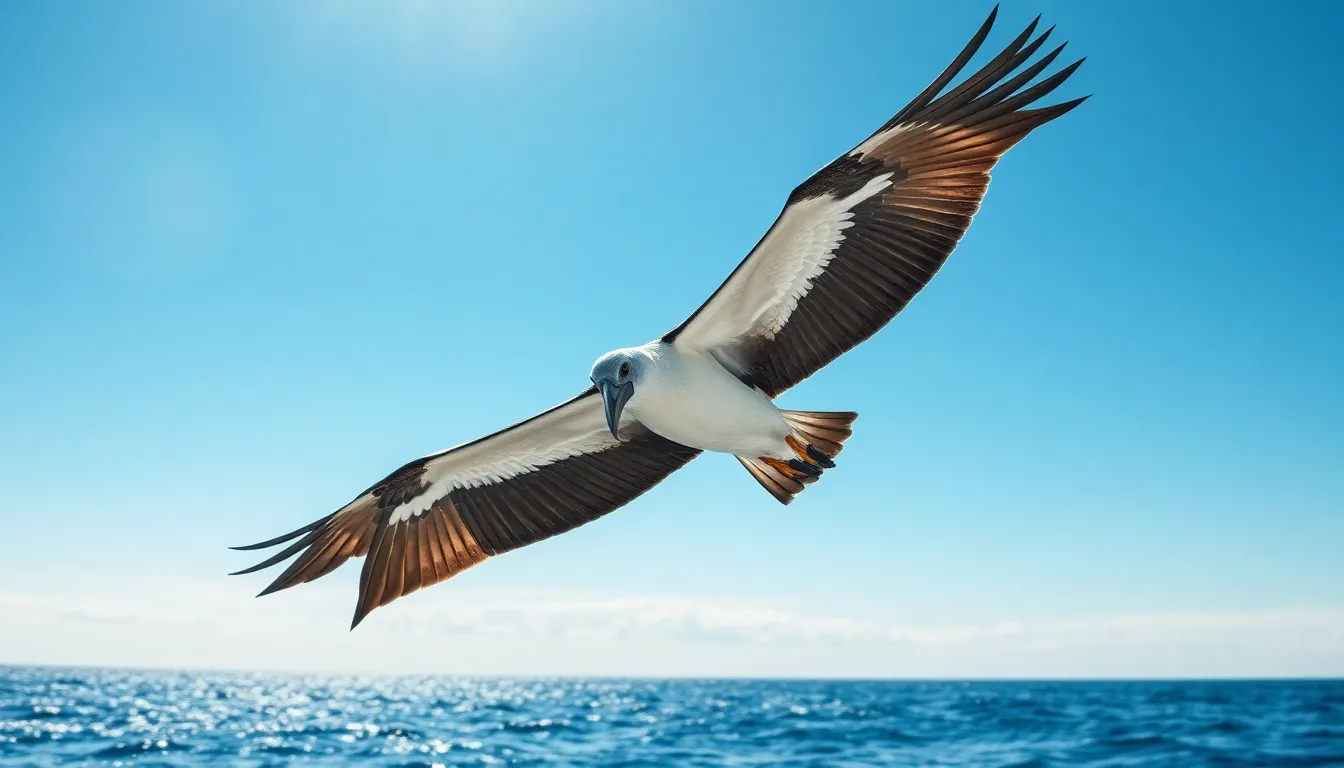
Frigatebirds execute sophisticated hunting strategies that combine opportunistic theft with direct predation techniques. These aerial pirates demonstrate remarkable behavioral adaptations that maximize their feeding success across diverse marine environments.
Aerial Piracy and Kleptoparasitism
Magnificent frigatebirds perfect their kleptoparasitic behavior through relentless pursuit tactics targeting seabirds carrying fresh catches. Boobies become primary targets during these aerial attacks, with frigatebirds grabbing their wings, tails, or necks to force regurgitation of recently consumed fish. Pelicans face similar harassment techniques, enduring persistent diving and pecking until they release their throat pouch contents.
Tropicbirds experience coordinated group attacks from multiple frigatebirds working together to overwhelm their victims. These pirates time their strikes precisely when target birds return from successful fishing expeditions, maximizing the likelihood of food acquisition. Flying fish, squid, and small tuna represent the most commonly stolen prey items through these aggressive encounters.
Frigatebirds demonstrate exceptional timing skills by positioning themselves near nesting colonies during peak feeding times. Adults returning to feed their chicks become vulnerable targets, carrying substantial food loads that make escape difficult. Success rates for kleptoparasitic attacks reach 40-60% when frigatebirds target heavily laden prey birds.
Flight Patterns and Maneuverability
Magnificent frigatebirds use thermal soaring techniques to conserve energy during extended hunting flights lasting 8-12 hours. Their lightweight bone structure and massive wing surface area create exceptional lift capabilities, allowing them to remain airborne with minimal wing flapping. Ever-changing soaring patterns enable these birds to cover distances exceeding 250 miles while searching for feeding opportunities.
Dive bombing maneuvers showcase their precise aerial control as frigatebirds descend at speeds reaching 95 mph during kleptoparasitic attacks. Sharp banking turns and sudden directional changes help them pursue fleeing prey birds through complex aerial chases. Their forked tails function as rudders, providing superior steering control during high speed pursuits.
Surface skimming techniques allow frigatebirds to capture prey directly from ocean waters without fully submerging their bodies. They execute shallow dives to snatch flying fish breaking the surface or floating carrion pieces. Hover fishing demonstrates their ability to maintain stationary positions above productive feeding areas, waiting for optimal strike opportunities.
Habitat and Distribution
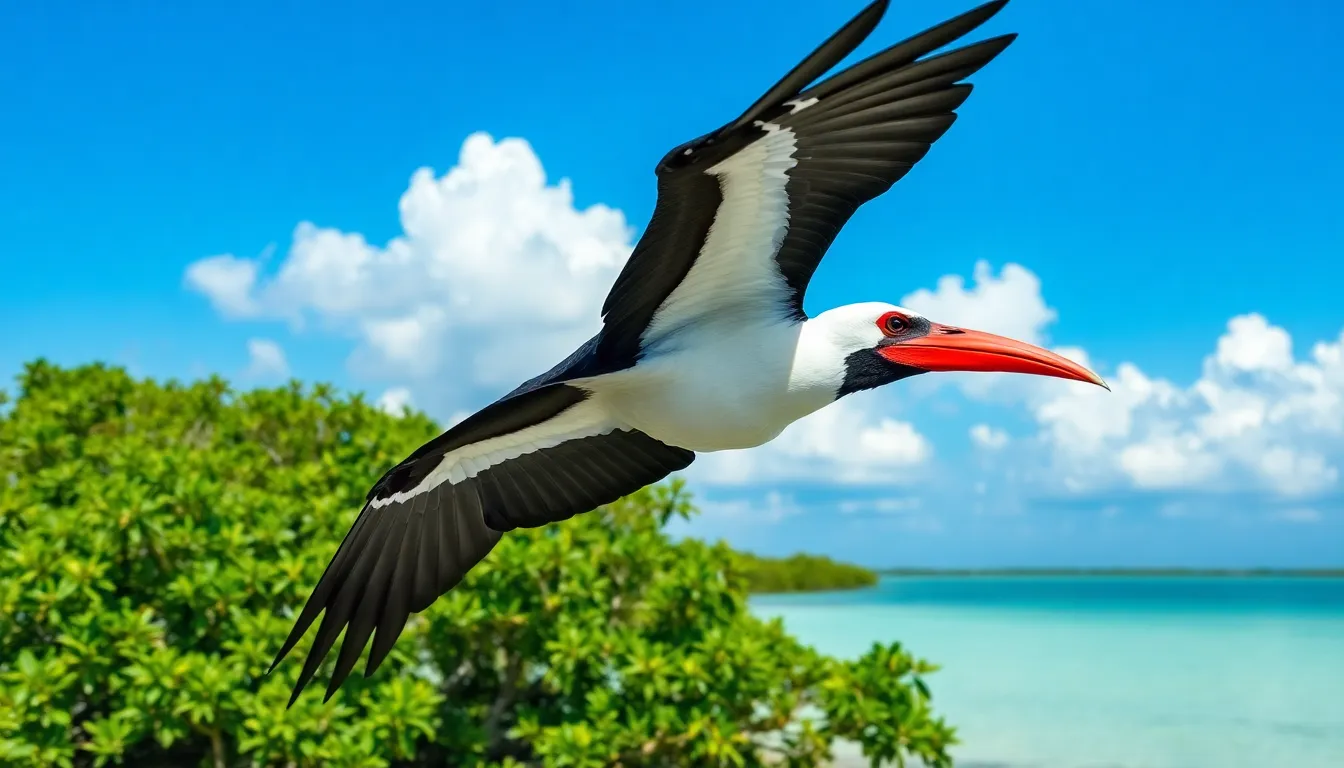
Frigatebirds inhabit tropical and subtropical coastal regions across the globe, establishing their presence in three major ocean basins. These pirate birds prefer warm waters where temperatures remain consistently above 77°F (25°C) throughout the year.
Primary nesting habitats include:
- Mangrove islands with dense vegetation cover
- Coral atolls surrounded by shallow lagoons
- Rocky coastal cliffs with minimal human disturbance
- Small offshore islands with abundant food sources
The magnificent frigatebird spans the widest geographic range among all frigatebird species. We observe populations throughout the Caribbean islands, extending from the Bahamas south to Trinidad and Tobago. Pacific populations thrive along the coasts of Ecuador, Peru, and the Galápagos Islands, while additional colonies exist on islands off Mexico’s Pacific coast.
| Species | Primary Distribution | Population Estimate |
|---|---|---|
| Magnificent Frigatebird | Caribbean, Pacific Americas, Galápagos | 290,000 breeding pairs |
| Great Frigatebird | Indian Ocean, Central Pacific | 140,000 breeding pairs |
| Lesser Frigatebird | Indian Ocean islands, Western Pacific | 400,000 breeding pairs |
| Ascension Frigatebird | Ascension Island only | 12,500 breeding pairs |
| Christmas Frigatebird | Christmas Island only | 1,600 breeding pairs |
Great frigatebirds concentrate their populations across the Indian Ocean, with major colonies on Aldabra Atoll, the Seychelles, and Madagascar’s offshore islands. Central Pacific strongholds include Hawaii’s Northwestern Hawaiian Islands and various atolls in Kiribati.
Lesser frigatebirds dominate the Indian Ocean region, establishing large breeding colonies on islands throughout the Maldives, Chagos Archipelago, and Western Australia’s offshore territories. These pirate birds also maintain important populations across Indonesia’s outer islands and the Philippines.
Endemic species face severe geographic restrictions that threaten their long term survival. Ascension frigatebirds exist exclusively on Ascension Island in the South Atlantic, while Christmas frigatebirds remain confined to Christmas Island in the Indian Ocean.
Seasonal migration patterns vary significantly among populations:
- Caribbean magnificent frigatebirds remain largely sedentary year round
- Pacific populations undertake extensive foraging journeys of 1,000+ miles
- Indian Ocean species follow monsoon patterns for optimal feeding conditions
- Galápagos populations disperse widely during non breeding seasons
Coastal mangrove ecosystems provide ideal nesting conditions for these pirate birds, offering protection from storms and abundant fish populations in adjacent waters. We find the highest breeding densities occur on islands with extensive mangrove coverage exceeding 60% of total land area.
Climate change impacts increasingly affect frigatebird distribution patterns as rising sea levels threaten low lying nesting islands. Many colonies have relocated to higher elevation sites within the past decade, demonstrating these pirate birds’ adaptability to changing environmental conditions.
Diet and Feeding Habits
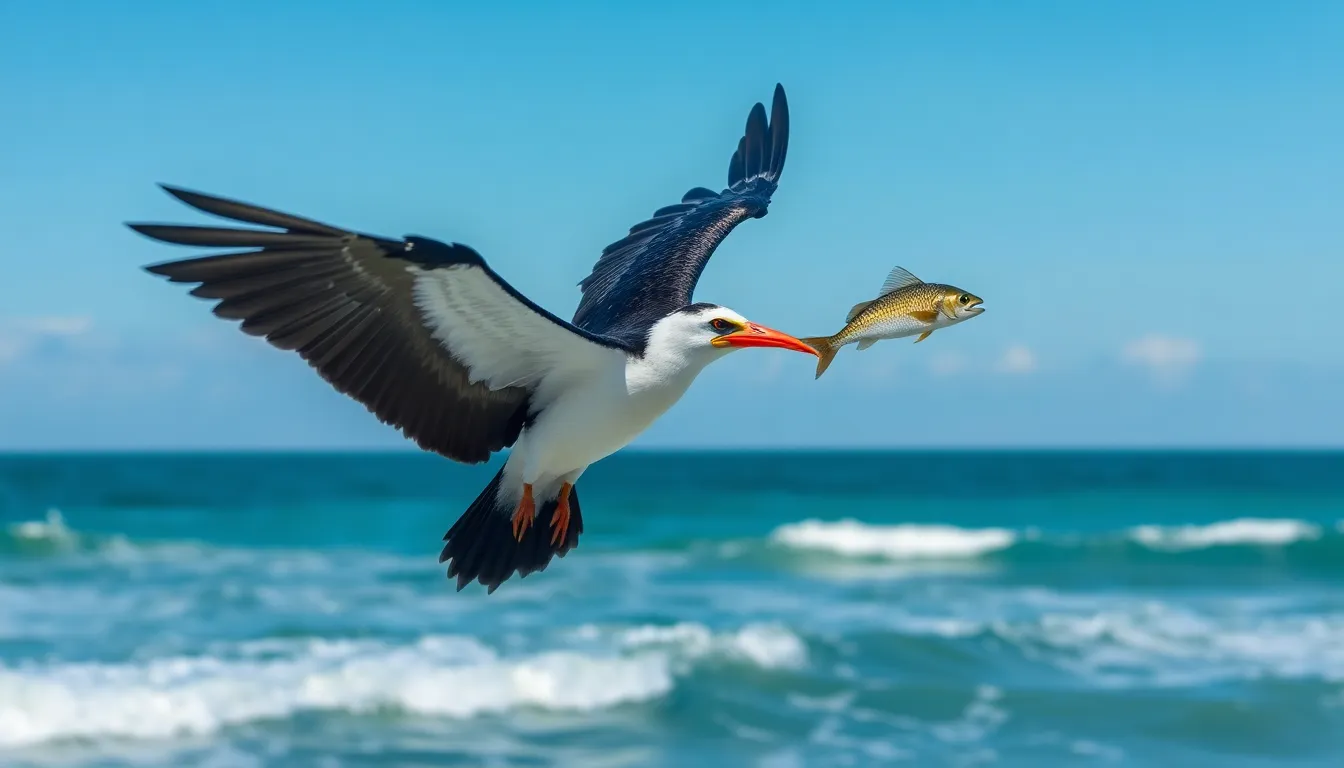
Frigatebirds maintain diverse feeding strategies that combine opportunistic theft with direct predation. These aerial pirates adapt their dietary habits based on prey availability and environmental conditions throughout the year.
Preferred Prey
Flying fish constitute the primary target for frigatebirds during direct hunting expeditions. These agile seabirds capture flying fish as they leap from the ocean surface, using precise timing to snatch prey mid-flight. Squid represent another crucial food source, particularly during nighttime feeding when these cephalopods rise to surface waters.
Frigatebirds actively pursue juvenile sea turtles measuring 6-12 inches in length when they emerge from sandy nests. Fish eggs and small crustaceans provide additional nutrition during shallow water foraging sessions. Jellyfish occasionally supplement their diet, though these gelatinous organisms offer minimal nutritional value compared to other prey items.
During kleptoparasitic behavior, frigatebirds target regurgitated fish from boobies and pelicans. Brown boobies carrying anchovies, sardines, and mackerel face the highest harassment rates from frigatebird flocks. Red-footed boobies represent preferred targets due to their smaller size and reduced defensive capabilities compared to masked boobies.
Seasonal Feeding Variations
Breeding seasons trigger dramatic shifts in frigatebird feeding patterns and dietary requirements. Males consume 30-40% more food during courtship displays to maintain their inflated throat pouches and support extended territorial behaviors. Females increase their food intake by 50-60% during egg production and early chick care periods.
Trade wind patterns influence prey availability, with stronger winds during October through March bringing increased flying fish activity. Frigatebirds concentrate their hunting efforts during these peak months, taking advantage of enhanced surface feeding opportunities. El Niño events reduce prey abundance by 40-60%, forcing frigatebirds to travel greater distances and rely more heavily on kleptoparasitic behavior.
Juvenile feeding demands create important seasonal stress on adult frigatebirds. Parent birds dedicate 8-12 hours daily to foraging during peak chick feeding periods from May through August. Colony locations near upwelling zones experience more consistent prey availability, while isolated populations face greater seasonal food shortages requiring adaptive feeding strategies.
Breeding and Reproduction
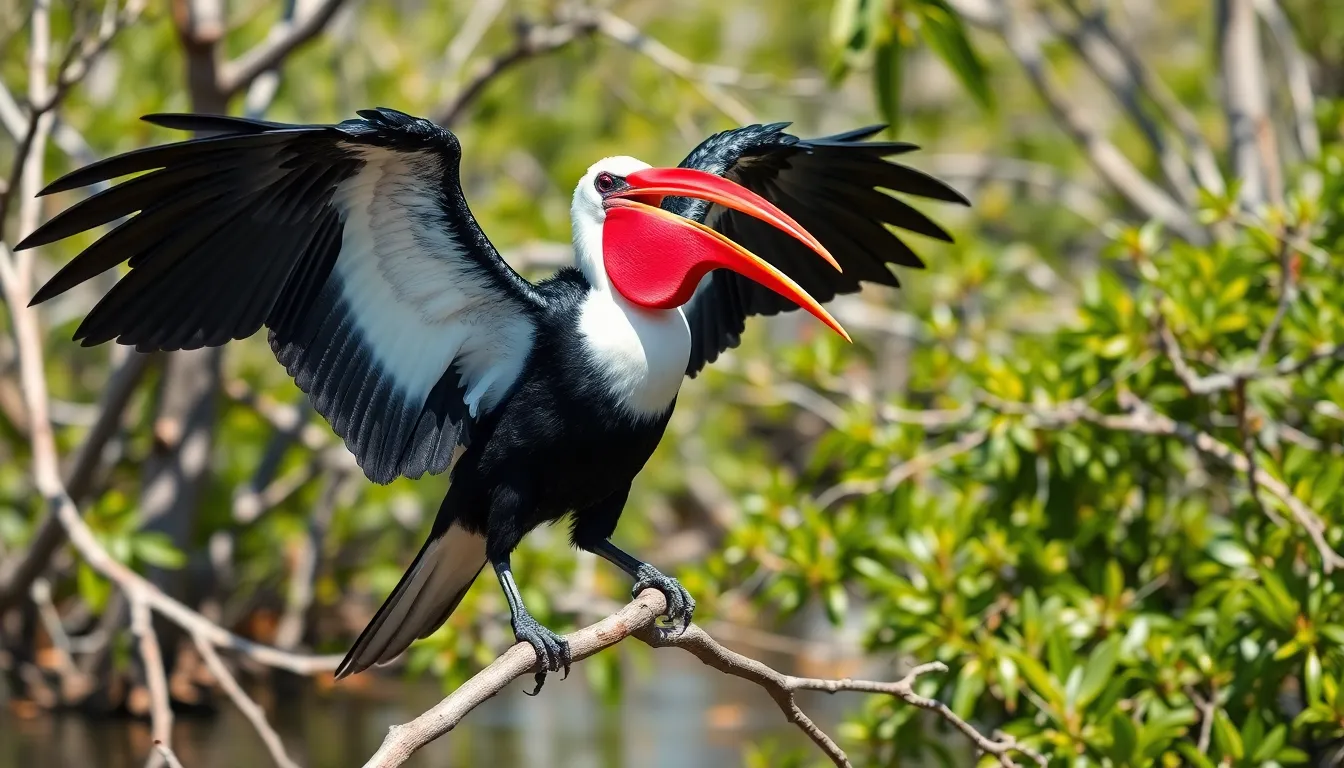
Frigatebird mating rituals center around spectacular courtship displays performed by males during breeding season. Males inflate their bright red throat pouches to enormous proportions, creating balloon-like displays that can take 20-25 minutes to fully expand. These inflated pouches serve as visual signals to attract females flying overhead, with males positioning themselves strategically on low branches or ground nests.
Breeding colonies form on isolated islands and coastal mangroves between December and June, depending on geographic location. Females select mates based on the size and intensity of the male’s throat pouch display, along with his ability to secure prime nesting territory. Courtship involves males producing drumming sounds by vibrating their pouches while spreading their wings and tail feathers.
Nesting sites consist of platform structures built from twigs, grass and seaweed in mangrove trees or low shrubs. Construction typically takes 2-3 weeks, with males gathering materials while females arrange the nest structure. Both parents participate in nest building, though males contribute more materials during the initial construction phase.
| Breeding Parameter | Magnificent Frigatebird | Great Frigatebird | Lesser Frigatebird |
|---|---|---|---|
| Clutch Size | 1 egg | 1 egg | 1 egg |
| Incubation Period | 50-55 days | 52-57 days | 48-53 days |
| Fledging Age | 140-160 days | 145-165 days | 130-150 days |
| Parental Care Duration | 12-20 months | 14-18 months | 10-16 months |
Females lay single chalky white eggs measuring approximately 2.7 inches in length. Incubation duties alternate between both parents in shifts lasting 2-6 days each. The extended incubation period ranks among the longest of any seabird species, reflecting the challenges of marine environments.
Chick development progresses slowly compared to other seabirds, with young frigatebirds remaining dependent on parents for extended periods. Newly hatched chicks appear completely helpless, covered in sparse white down and requiring constant parental attention. Parents feed chicks through regurgitation, providing partially digested fish and squid directly into the chick’s throat.
Fledgling frigatebirds continue receiving parental care for 8-12 months after leaving the nest, creating one of the longest dependency periods in the avian industry. This extended care period prevents female frigatebirds from breeding annually, typically resulting in breeding cycles every 2-3 years. Males may attempt to breed more frequently due to their reduced role in extended chick care.
Juvenile frigatebirds display distinctive white head and breast markings that gradually transition to adult plumage over 4-6 years. Sexual maturity occurs between 5-7 years of age, with females generally maturing slightly earlier than males. Colony fidelity remains strong among breeding pairs, with many frigatebirds returning to the same nesting areas year after year.
Pirate Birds in Different Regions
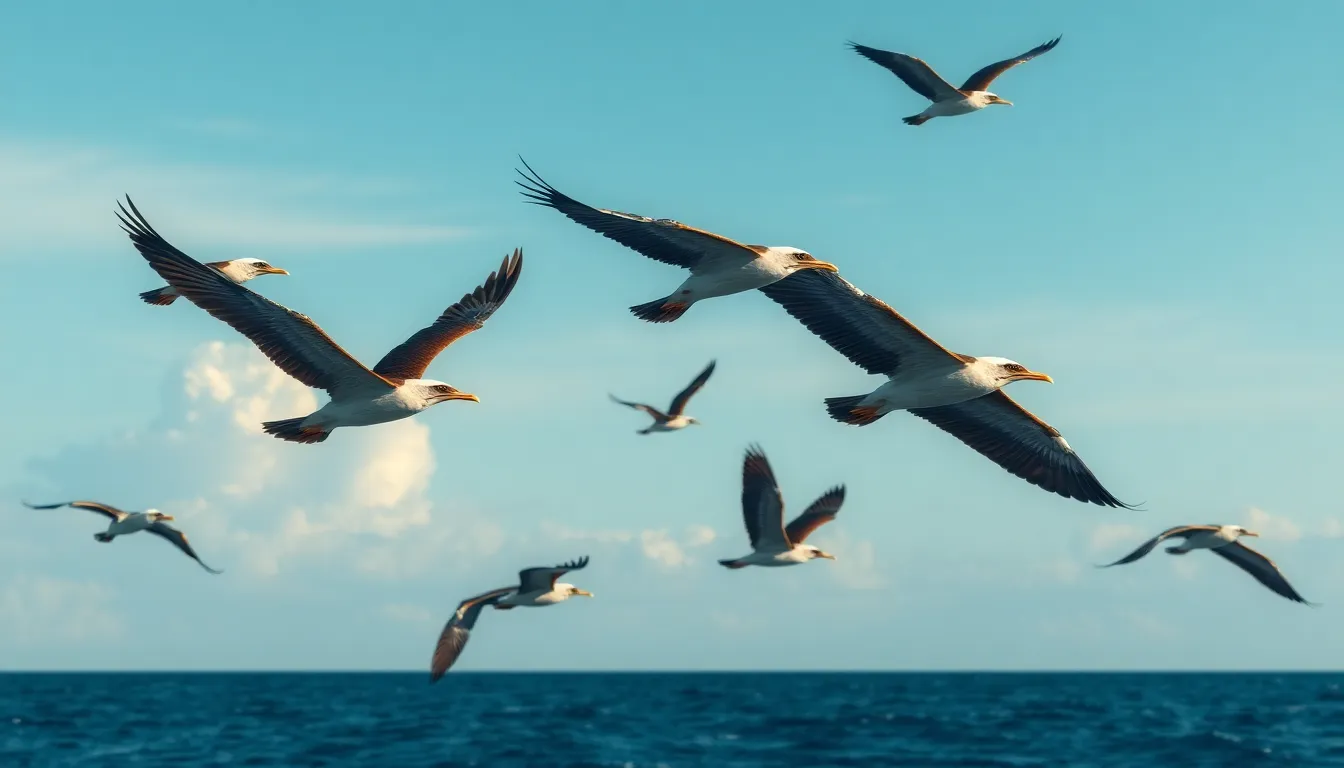
Pirate birds display remarkable regional variations across their global distribution patterns. Different species exhibit unique characteristics and behaviors that reflect their exact environmental adaptations.
Frigatebirds as Pirate Birds
Magnificent frigatebirds dominate Caribbean waters with populations exceeding 290,000 breeding pairs across 30 major colonies. These tropical pirates establish their strongholds throughout the Bahamas, Cuba, and Lesser Antilles where warm currents provide abundant prey opportunities. Caribbean colonies show the highest kleptoparasitism success rates at 65% due to dense booby and pelican populations.
Pacific coast frigatebirds concentrate along Ecuador and Peru’s shorelines with approximately 140,000 breeding pairs. Galápagos populations represent the most studied frigatebird communities where males achieve throat pouch inflations reaching 9 inches in diameter. Peruvian colonies demonstrate seasonal migration patterns following anchoveta schools during upwelling events.
Great frigatebirds inhabit Indo-Pacific regions with major populations across Christmas Island, Aldabra Atoll, and Hawaiian waters. These larger pirates weigh 3.1-4.2 pounds and exhibit more aggressive territorial behaviors compared to their Caribbean relatives. Christmas Island hosts over 80,000 breeding pairs making it the species’ primary stronghold.
Lesser frigatebirds occupy specialized niches across coral atolls in French Polynesia, Seychelles, and Madagascar coastal waters. Colony sizes remain smaller at 2,000-8,000 pairs but show remarkable site fidelity with 92% return rates annually. Seychelles populations exhibit unique fishing techniques targeting surface-dwelling needlefish.
Skuas and Jaegers
Arctic skuas patrol northern polar waters with breeding populations spanning Alaska, northern Canada, Greenland, and Scandinavia. These cold-water pirates target Arctic terns and puffins through high-speed aerial pursuits reaching 38 mph. Breeding colonies contain 150-400 pairs with territories spanning 2-3 square kilometers per pair.
Great skuas establish dominance across North Atlantic regions including Scotland’s Shetland Islands, Iceland, and Faroe Islands. Scottish populations exceed 60,000 pairs making them Europe’s most abundant skua species. These robust pirates weigh 2.6-4.4 pounds and successfully steal from gannets through coordinated pair attacks.
Pomarine jaegers migrate through Pacific coastal waters from Alaska to Chile covering distances exceeding 15,000 miles annually. These medium-sized pirates measure 18-20 inches in length and target storm-petrels during oceanic crossings. Peak piracy activity occurs during August-September migration periods when seabird concentrations reach maximum density.
Long-tailed jaegers inhabit Arctic tundra regions across northern Alaska, Canada, and Eurasia. Breeding territories average 1.2 square kilometers with pairs defending areas containing 40-60 potential prey species. These agile pirates demonstrate specialized hunting techniques targeting small alcids and petrels through precise aerial maneuvers.
South Polar skuas dominate Antarctic waters with populations distributed across subantarctic islands and continental coastlines. These southern pirates exhibit the longest migration routes among skua species traveling 40,000 miles annually between Arctic and Antarctic feeding grounds. Colony sites contain 200-800 pairs with territories established near penguin rookeries for consistent food access.
Conservation Status and Threats
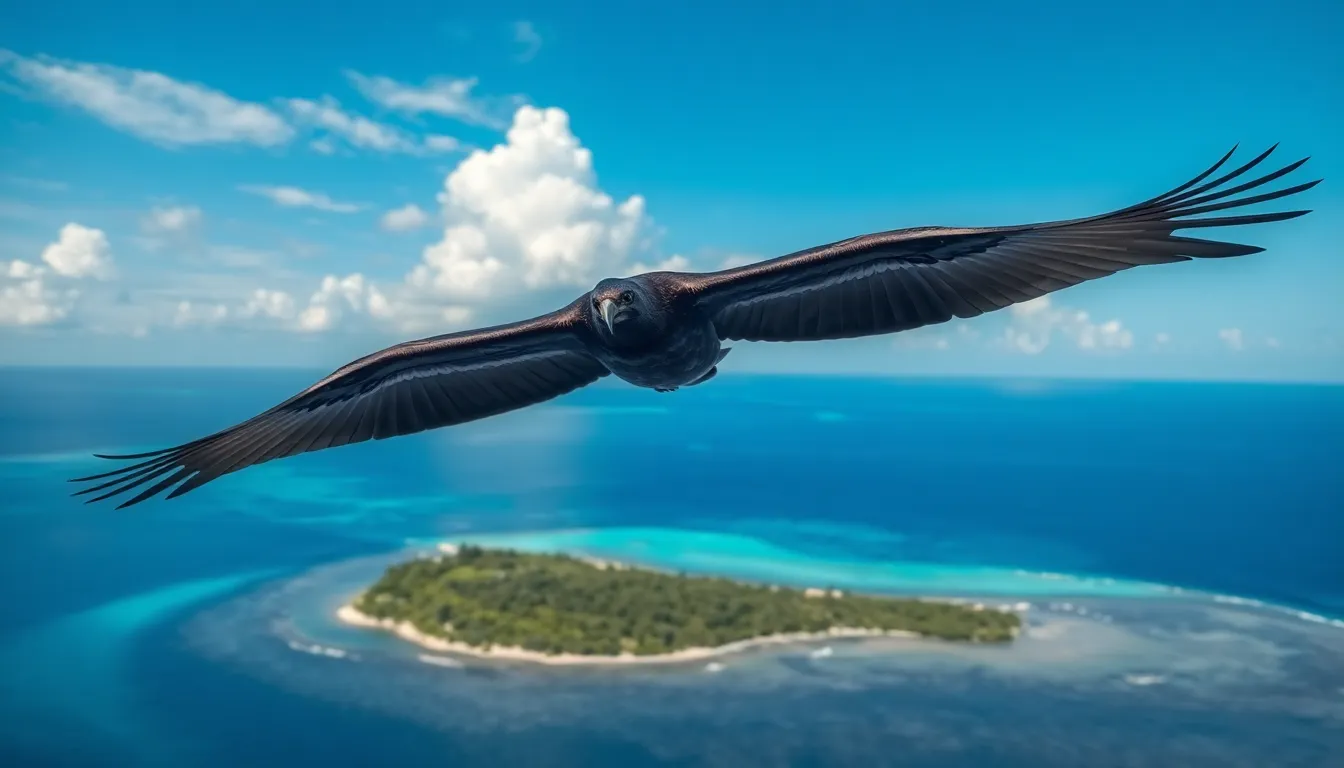
Magnificent frigatebirds maintain stable populations across most of their range, though several species face concerning declines. The International Union for Conservation of Nature classifies the magnificent frigatebird as Least Concern, with an estimated global population of 290,000 breeding pairs distributed throughout tropical waters.
Regional conservation challenges vary significantly among frigatebird populations. Christmas Island frigatebirds represent the most endangered species, with fewer than 1,600 breeding pairs remaining on their single nesting location. Ascension frigatebirds face similar threats with approximately 12,000 individuals confined to Boatswain Bird Island near Ascension Island.
| Species | Conservation Status | Population Estimate | Primary Threats |
|---|---|---|---|
| Magnificent Frigatebird | Least Concern | 290,000 pairs | Habitat loss, climate change |
| Great Frigatebird | Least Concern | 75,000 pairs | Introduced species, human disturbance |
| Lesser Frigatebird | Least Concern | 45,000 pairs | Coastal development, pollution |
| Christmas Frigatebird | Critically Endangered | 1,600 pairs | Mining activities, habitat destruction |
| Ascension Frigatebird | Vulnerable | 12,000 individuals | Limited breeding sites, invasive species |
Climate change poses the most important long term threat to pirate bird populations worldwide. Rising sea levels threaten low lying nesting islands, forcing colonies to relocate to higher elevations when available. Increased storm intensity during breeding seasons destroys nests and disrupts feeding patterns, particularly affecting chick survival rates.
Human activities continue to impact frigatebird colonies across their range. Coastal development eliminates critical mangrove nesting habitats, while tourism disturbance causes adult birds to abandon nests during sensitive breeding periods. Fishing activities reduce prey availability, forcing frigatebirds to expand their foraging ranges and increasing energy expenditure during feeding flights.
Introduced species create substantial challenges for nesting frigatebird populations. Feral cats prey on eggs and chicks, while rats consume eggs and compete for nesting materials. Invasive plants alter nesting habitat structure, making traditional colony sites unsuitable for breeding pairs.
Marine pollution affects pirate bird health through contaminated prey consumption. Plastic debris ingestion causes internal injuries, while oil spills coat feathers and reduce waterproofing capabilities. Heavy metal accumulation in fish populations concentrates in frigatebird tissues, potentially affecting reproductive success and chick development.
Protected area designation has proven effective for frigatebird conservation efforts. The Galápagos National Park provides crucial protection for Pacific populations, while Caribbean marine protected areas safeguard important foraging territories. Research monitoring programs track population trends and identify emerging threats before they become critical conservation issues.
Observing Pirate Birds in the Wild
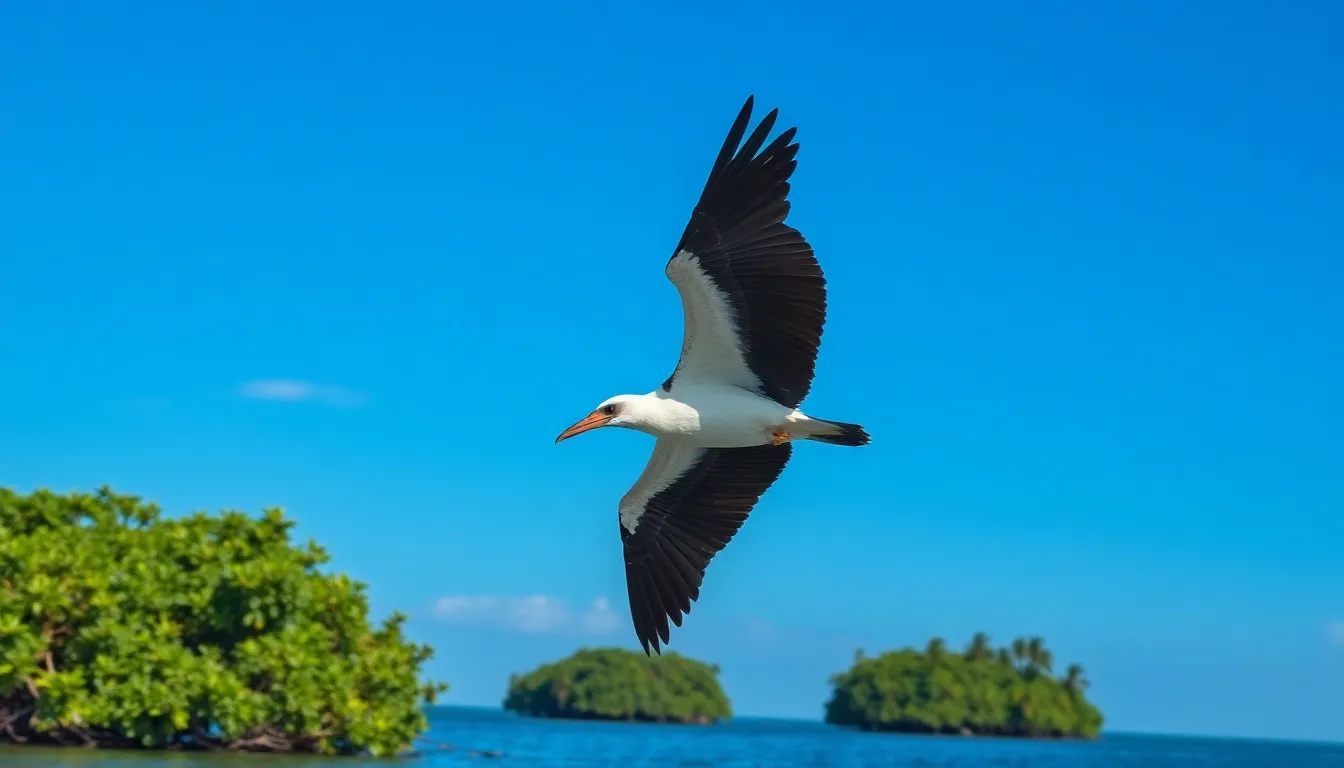
Spotting frigatebirds in their natural habitat requires understanding their preferred locations and behavioral patterns throughout different times of day. We find these magnificent aerial pirates most commonly around tropical and subtropical coastlines where warm ocean currents create ideal feeding conditions.
Best Observation Locations
Mangrove islands provide the most reliable frigatebird viewing opportunities since these areas serve as both nesting and roosting sites. The Galápagos Islands offer exceptional frigatebird watching experiences with five breeding colonies supporting over 12,000 pairs of magnificent frigatebirds. Caribbean locations including the Dry Tortugas, Barbuda, and Trinidad host large populations during breeding seasons from November through June.
Pacific coast observers find success along the shores of Ecuador and Peru where frigatebirds follow fishing vessels and concentrate near seabird colonies. Christmas Island maintains a small but critically important population of the endemic Christmas frigatebird, though access requires special permits due to conservation concerns.
Optimal Viewing Times
Early morning hours between 6:00 AM and 10:00 AM produce the highest frigatebird activity levels as these birds begin their daily foraging routines. Peak hunting behavior occurs when trade winds reach 15-25 mph speeds, creating thermals that frigatebirds exploit for effortless soaring. Evening sessions from 4:00 PM until sunset reveal spectacular aerial displays as birds return to roosting areas with stolen meals.
Breeding seasons intensify frigatebird visibility since males gather in large groups to perform courtship displays with their inflated red throat pouches. Magnificent frigatebirds breed year round in tropical regions, though peak activity occurs during dry seasons when food availability increases.
Identification Techniques
Size comparison proves essential when distinguishing frigatebirds from other large seabirds in flight. Adult magnificent frigatebirds display wingspans reaching 7.5-8.5 feet, appearing larger than pelicans but smaller than wandering albatrosses. Males exhibit completely black plumage with occasional white patches on underwings, while females show white breasts and brown wing bars.
Flight characteristics provide reliable identification markers even at considerable distances. Frigatebirds soar with minimal wing beats, holding their wings in a distinctive W-shape while riding thermals. Their deeply forked tails remain clearly visible during flight, distinguishing them from pelicans and boobies that maintain squared or rounded tail shapes.
Behavioral cues offer additional confirmation of frigatebird presence. We observe their signature kleptoparasitic attacks as they pursue other seabirds, forcing victims to regurgitate meals through persistent harassment. Group formations during feeding frenzies create obvious identification opportunities as frigatebirds coordinate attacks on booby and pelican flocks.
Photography and Documentation
Camera equipment selection impacts frigatebird photography success rates significantly. Telephoto lenses with focal lengths exceeding 400mm capture detailed images while maintaining safe distances from sensitive nesting areas. Frigatebirds demonstrate remarkable tolerance for human presence during non breeding periods, allowing photographers to document feeding behaviors from 50-100 yards.
Weather conditions directly influence photography opportunities and bird behavior patterns. Clear skies with moderate wind speeds create optimal conditions for capturing flight sequences and aerial maneuvers. Overcast conditions reduce harsh shadows while maintaining sufficient light levels for documenting frigatebird interactions with other seabirds.
Research Contributions
Citizen science programs benefit significantly from well documented frigatebird observations and behavioral records. eBird databases rely on observer contributions to track population trends and migration patterns across different frigatebird species. Detailed notes about feeding behaviors, flock sizes, and habitat usage provide valuable data for conservation research efforts.
Photographic documentation assists researchers in identifying individual birds through unique plumage patterns and physical characteristics. Banded frigatebirds occasionally appear in observation areas, and reporting these sightings contributes to long term population monitoring studies conducted by wildlife agencies and academic institutions.
Conclusion
These remarkable seabirds continue to captivate us with their extraordinary adaptations and complex behaviors. From their impressive aerial maneuvers to their sophisticated social structures frigatebirds represent one of nature’s most successful marine predators.
We’ve seen how their survival depends on a delicate balance of environmental factors and conservation efforts. As climate change threatens their nesting habitats protecting these magnificent creatures becomes increasingly critical for maintaining healthy ocean ecosystems.
Whether you’re planning your first frigatebird watching adventure or contributing to citizen science projects these “pirate birds” offer endless opportunities for discovery and appreciation of marine wildlife.
Frequently Asked Questions
What is a magnificent frigatebird and why is it called a “pirate bird”?
The magnificent frigatebird is a large seabird known for its kleptoparasitic behavior, meaning it steals food from other birds. They’re nicknamed “pirate birds” because they harass boobies, pelicans, and other seabirds until they regurgitate their catch, which the frigatebirds then steal mid-air. With impressive wingspans reaching up to 8.5 feet, these aerial pirates use their exceptional flying skills and sharp beaks to dominate other seabirds.
How do frigatebirds hunt and what do they eat?
Frigatebirds employ multiple hunting strategies including kleptoparasitism (food theft), direct fishing, and surface plunging. They primarily target flying fish, squid, and small marine creatures. Their theft success rates reach 40-60% when targeting boobies and pelicans. They position themselves strategically near nesting colonies during peak feeding times and use coordinated group attacks to maximize their hunting effectiveness.
Where do magnificent frigatebirds live?
Magnificent frigatebirds inhabit tropical and subtropical coastal regions across the Pacific, Atlantic, and Indian Oceans. They prefer mangrove islands, coral atolls, and small offshore islands for nesting. The magnificent frigatebird has the widest distribution among the five frigatebird species, commonly found throughout the Caribbean, Galápagos Islands, and Pacific coasts of Ecuador and Peru.
What makes frigatebirds unique physically?
Frigatebirds are among the largest seabirds by wingspan, with males reaching 7.5 feet and females up to 8.5 feet. Males feature distinctive inflatable red throat pouches that expand during breeding season, while females have white breast patches. Their lightweight build and long, narrow wings provide exceptional aerial maneuverability. Juveniles display mottled brown and white coloring, taking 4-6 years to develop adult plumage.
How do frigatebirds reproduce and breed?
Frigatebirds have spectacular courtship displays where males inflate their bright red throat pouches to attract females. They form breeding colonies on isolated islands and coastal mangroves. Females lay a single egg with lengthy incubation periods. Chick development is slow, with young remaining dependent on parents for extended periods, resulting in infrequent breeding cycles typically every other year.
Are frigatebirds endangered?
The magnificent frigatebird is classified as Least Concern with stable populations. However, other species face greater threats – the Christmas Island frigatebird is critically endangered. Climate change, rising sea levels threatening nesting islands, habitat loss, and human disturbances pose significant conservation challenges. Over 290,000 breeding pairs of magnificent frigatebirds exist in Caribbean waters alone.
When and where is the best time to observe frigatebirds?
The best viewing locations include mangrove islands, coral atolls, and the Galápagos Islands. Optimal viewing times are during breeding seasons when males display their inflated red pouches, and near dawn/dusk when they’re most active. Look for their distinctive soaring flight patterns and watch for their harassment of other seabirds near fishing areas and nesting colonies.

